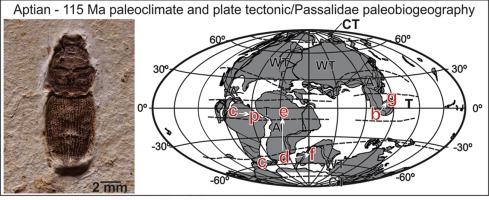当前位置:
X-MOL 学术
›
Cretac. Res.
›
论文详情
Our official English website, www.x-mol.net, welcomes your
feedback! (Note: you will need to create a separate account there.)
A new passalid fossil (Insecta: Coleoptera) from the Santana formation (Crato member, lower Cretaceous), Araripe basin, Ne Brazil: Paleoecologic and paleobiogeographic implications
Cretaceous Research ( IF 1.9 ) Pub Date : 2021-02-01 , DOI: 10.1016/j.cretres.2020.104664 Márcia Fernandes de Aquino Santos , Ingrid Mattos , José Ricardo M. Mermudes , Sandro Marcelo Scheffler , Pedro Reyes-Castillo
Cretaceous Research ( IF 1.9 ) Pub Date : 2021-02-01 , DOI: 10.1016/j.cretres.2020.104664 Márcia Fernandes de Aquino Santos , Ingrid Mattos , José Ricardo M. Mermudes , Sandro Marcelo Scheffler , Pedro Reyes-Castillo

|
Abstract Species with a xylobiont lifestyle (e.g., inside fallen tree trunks) are rarely fossilized because of their taphonomic peculiarities. Reconstructing the evolutionary history of these lineages is challenging, especially with respect to dating major events. Here, a new genus and species of Passalidae, Protopassalus araripensis gen. et sp. nov., is described based on a well-preserved fossil in laminated limestone from the Crato Formation (Santana Group, Lower Cretaceous, upper Aptian), collected in a quarry near Nova Olinda, Chapada do Araripe, State of Ceara, Brazil. This specimen is the oldest passalid fossil and the first record for the family in the Santana Group, and aids in understanding the origin and radiation of terrestrial Coleoptera. Protopassalus araripensis gen. et sp. nov. shows characteristics of the subfamily Passalinae, representing the oldest record of this group and suggesting that the family emerged over 150 Ma. The new genus is attributed to this subfamily based on: outline of head and eyes with strongly convex frontal area, posteriorly grooved and curve, with incomplete central tubercle; pronotum rounded at sides with longitudinal groove; mesothorax with narrowing connection with abdomen, dorsally evident; elytra longitudinally striated and with similar dorsal striae and interstriae. We propose a new sequence of events in the Passalidae paleobiogeography, as a basis to evaluate other organisms of low dispersal ability.
中文翻译:

来自巴西内布拉斯加州阿拉里佩盆地桑塔纳地层(克拉托成员,下白垩纪)的一种新的passalid化石(昆虫纲:鞘翅目):古生态学和古生物地理意义
摘要 具有木生物生活方式的物种(例如,在倒下的树干内)由于它们的埋藏学特性很少被化石化。重建这些谱系的进化历史具有挑战性,尤其是在确定重大事件的年代。在这里,Passalidae 的一个新属和种,Protopassalus araripensis gen。等 sp. 11 月,是根据在巴西塞阿拉州 Chapada do Araripe,Chapada do Araripe,Nova Olinda 附近的一个采石场收集的 Crato 组(Santana Group,下白垩纪,上 Aptian)的层状石灰岩中保存完好的化石进行描述的。该标本是最古老的 passalid 化石,也是桑塔纳群中该科的第一个记录,有助于了解陆生鞘翅目的起源和辐射。Protopassalus araripensis 基因。等 sp. 十一月 显示亚科 Passalinae 的特征,代表了这个群体中最古老的记录,并表明该家族出现了 150 多 Ma。新属属于这个亚科,基于:头部和眼睛的轮廓具有强烈的额部凸出,后部有凹槽和曲线,中央结节不完整;前胸片两侧呈圆形,带有纵向凹槽;中胸与腹部连接变窄,背部明显;鞘翅纵向有条纹,背纹和间纹相似。我们在 Passalidae 古生物地理学中提出了一个新的事件序列,作为评估其他低扩散能力的生物的基础。中央结节不完整;前胸片两侧呈圆形,带有纵向凹槽;中胸与腹部连接变窄,背部明显;鞘翅纵向有条纹,背纹和间纹相似。我们在 Passalidae 古生物地理学中提出了一个新的事件序列,作为评估其他低扩散能力的生物的基础。中央结节不完整;前胸片两侧呈圆形,带有纵向凹槽;中胸与腹部连接变窄,背部明显;鞘翅纵向有条纹,背纹和间纹相似。我们在 Passalidae 古生物地理学中提出了一个新的事件序列,作为评估其他低扩散能力的生物的基础。
更新日期:2021-02-01
中文翻译:

来自巴西内布拉斯加州阿拉里佩盆地桑塔纳地层(克拉托成员,下白垩纪)的一种新的passalid化石(昆虫纲:鞘翅目):古生态学和古生物地理意义
摘要 具有木生物生活方式的物种(例如,在倒下的树干内)由于它们的埋藏学特性很少被化石化。重建这些谱系的进化历史具有挑战性,尤其是在确定重大事件的年代。在这里,Passalidae 的一个新属和种,Protopassalus araripensis gen。等 sp. 11 月,是根据在巴西塞阿拉州 Chapada do Araripe,Chapada do Araripe,Nova Olinda 附近的一个采石场收集的 Crato 组(Santana Group,下白垩纪,上 Aptian)的层状石灰岩中保存完好的化石进行描述的。该标本是最古老的 passalid 化石,也是桑塔纳群中该科的第一个记录,有助于了解陆生鞘翅目的起源和辐射。Protopassalus araripensis 基因。等 sp. 十一月 显示亚科 Passalinae 的特征,代表了这个群体中最古老的记录,并表明该家族出现了 150 多 Ma。新属属于这个亚科,基于:头部和眼睛的轮廓具有强烈的额部凸出,后部有凹槽和曲线,中央结节不完整;前胸片两侧呈圆形,带有纵向凹槽;中胸与腹部连接变窄,背部明显;鞘翅纵向有条纹,背纹和间纹相似。我们在 Passalidae 古生物地理学中提出了一个新的事件序列,作为评估其他低扩散能力的生物的基础。中央结节不完整;前胸片两侧呈圆形,带有纵向凹槽;中胸与腹部连接变窄,背部明显;鞘翅纵向有条纹,背纹和间纹相似。我们在 Passalidae 古生物地理学中提出了一个新的事件序列,作为评估其他低扩散能力的生物的基础。中央结节不完整;前胸片两侧呈圆形,带有纵向凹槽;中胸与腹部连接变窄,背部明显;鞘翅纵向有条纹,背纹和间纹相似。我们在 Passalidae 古生物地理学中提出了一个新的事件序列,作为评估其他低扩散能力的生物的基础。










































 京公网安备 11010802027423号
京公网安备 11010802027423号